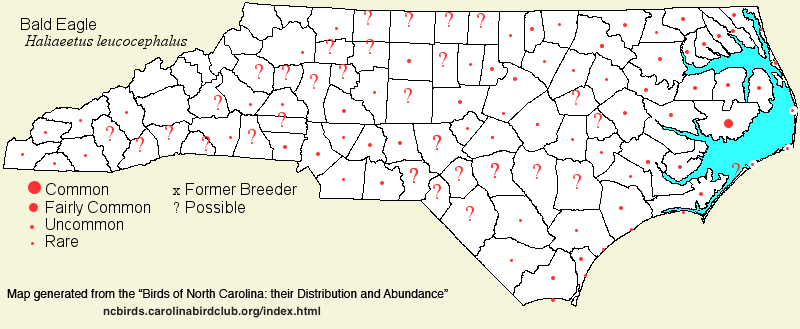 |  |
|
Bald Eagle - Haliaeetus leucocephalus ACCIPITRIDAE Members: | Search Common: Search Scientific: |
|
|
|||||||
| General Comments | The national symbol needs no introduction to birders, and it has had a very cyclical history in North Carolina over the past century. Prior to 1965, the Bald Eagle was a widespread and not uncommon breeding bird along the coast and in the Tidewater areas. However, because of the near lack of large lakes west of Lake Mattamuskeet, no eagles nested in the inner Coastal Plain, Piedmont, or mountains. However, because of DDT accumulation in the birds, from eating of contaminated fishes, eggs laid by eagles had thin shells that broke under the weight of the incubating adults, and the state's breeding population -- unlike that in neighboring Virginia and South Carolina -- crashed to zero pairs until about 1984, well after DDT was banned in this country. Because eagles tend to return to the general area where they were born to breed in later years, the chance of eagles nesting on their own in North Carolina was bleak unless some actions were taken. The state's Wildlife Resources Commission felt the need to start a hacking program at Lake Mattamuskeet, such that juvenile birds would be imprinted on the local region. From this program, and probably owing to an increase in nesting birds from neighboring states looking for new nesting territories, the state's nesting population began to grow, exponentially! Several new nests have appeared each year since, and certainly over 100 nests are now scattered across most of the state. Bald Eagles almost always forage near water, both coastally and inland. They are most numerous at large freshwater lakes, both natural ones (such as Lake Mattamuskeet) and reservoirs (such as Jordan Lake). They also forage at large tidal rivers and bays, but are less numerous in salt water areas such as the ocean or tidal channels. Nest sites are typically in large living pines or cypresses, especially close to water and where the birds have a commanding view of their surroundings. | ||||||
| Breeding Status | Breeder | ||||||
| NC BRC List | Definitive | ||||||
| State Status | T | ||||||
| U.S. Status | |||||||
| State Rank | S3B,S3N | ||||||
| Global Rank | G5 | ||||||
| Coastal Plain | Year-round resident, with some migratory movements. Uncommon but increasing along most of the coast; uncommon to locally common in the Tidewater area, particularly around Lake Mattamuskeet. Uncommon to locally fairly common farther inland. Nests over most of the region, but absent as a breeder (so far) in the Sandhills region and a few other counties where large lakes are lacking. Most numerous/widespread as a breeder close to Albemarle Sound and the lower Neuse/Pamlico rivers; surprisingly scarce as a breeder in southern coastal areas and on the Outer Banks. Numbers in the province tend to be highest in winter. Peak counts: 102, Roper catfish ponds, 17 Nov 2007. | ||||||
| Piedmont | Year-round resident, with migratory movements. Uncommon to locally fairly common over the region, especially at a few large resevoirs (Jordan, Falls, lakes along the Yadkin/Pee Dee, etc.). Unlike in the Coastal Plain, highest numbers are in late summer. Breeding pairs are increasing, with nesting now at many or most lakes in the western section, as well as farther east. Peak counts: 54, Jordan Lake, 2 May 2009; 53, Jordan Lake, during August 1986. | ||||||
| Mountains | Nearly year-round visitor; known to be nesting at scattered large lakes in the southwestern counties. Generally rare to uncommon, but increasing, mostly around lakes. Habitat for the species is relatively scarce in the province, especially for nesting, though new nesting locales will almost certainly increase in upcoming years. Peak counts: ? | ||||||
| Finding Tips |
Bald Eagles are usually easily found along the causeway (NC 94) at Lake Mattamuskeet, or from the roads on the refuge east of the causeway. Jordan Lake is probably the best site in the Piedmont for seeing them. However, an hour or two spent around a fairly large lake over most of the state ought to turn up one or two birds. *** | ||||||
| Attribution | LeGrand[2023-03-21], LeGrand[2018-02-02], LeGrand[2012-05-19] | ||||||
| NC Map Map depicts all counties with a report (transient or resident) for the species. | Click on county for list of all known species. |
| NC Breeding Season Map Map depicts assumed breeding season abundance for the species. |  |